boot Citroen C4 RHD 2015 2.G Owner's Guide
[x] Cancel search | Manufacturer: CITROEN, Model Year: 2015, Model line: C4 RHD, Model: Citroen C4 RHD 2015 2.GPages: 328, PDF Size: 12.72 MB
Page 184 of 328
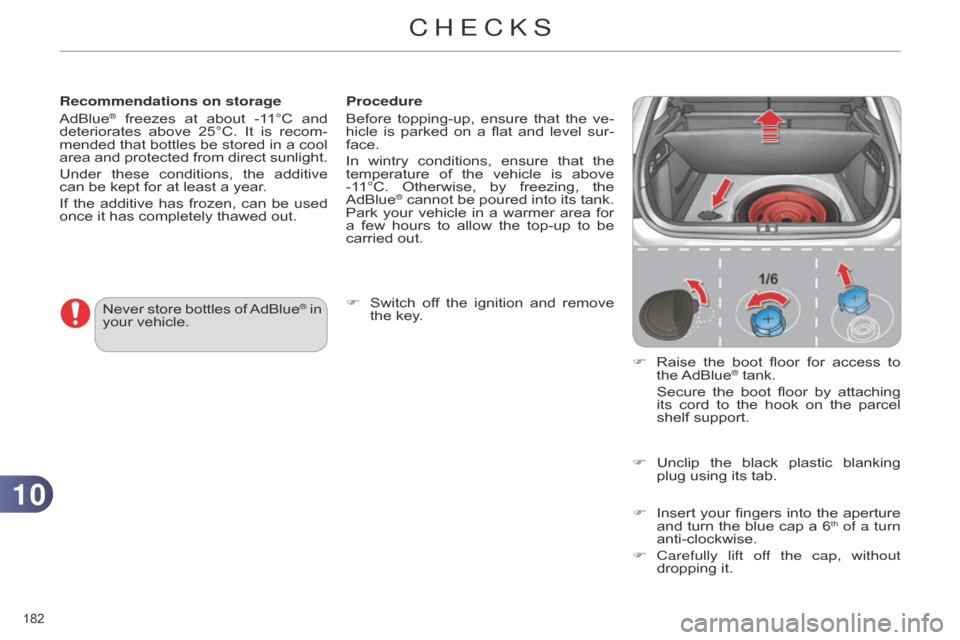
1010
182ô
Recommendations on storage
AdBlueôÛô freezesô at ô about ô -1 1ô¯C ô and ô deteriorates
ô above ô 25ô¯C. ô It ô is ô recom -
mended
ô
that
ô
bottles
ô
be
ô
stored
ô
in
ô
a
ô
cool
ô
area
ô
and
ô
protected
ô
from
ô
direct
ô
sunlight.
Under
ô
these
ô
conditions,
ô
the
ô
additive
ô
can
ô
be
ô
kept ô for ô at ô least ô a ô year.
If
ô
the
ô
additive
ô
has
ô
frozen,
ô
can
ô
be
ô
used
ô
once
ô
it
ô
has ô completely ô thawed ô out.
Never
ô
store
ô
bottles
ô
of
ô
AdBlueôÛ in
your
ô
vehicle. Procedure
Before
ô
topping-up,
ô
ensure
ô
that
ô
the
ô
ve
-
hicle ô
is
ô
parked
ô
on
ô
a
ô
flat
ô
and
ô
level
ô
sur
-
face.
In ô
wintry
ô
conditions,
ô
ensure
ô
that
ô
the
ô
temperature
ô
of
ô
the
ô
vehicle
ô
is
ô
above
ô
-1
1ô¯C. ô
Otherwise,
ô
by
ô
freezing,
ô
the
ô
AdBlueôÛô cannot
ô be ô poured ô into ô its ô tank. ô Park
ô your ô vehicle ô in ô a ô warmer ô area ô for ô
a
ô
few
ô
hours
ô
to
ô
allow
ô
the
ô
top-up
ô
to
ô
be
ô
carried
ô
out.
F
ô
Switch
ô
of
f ô
the
ô
ignition
ô
and
ô
remove
ô
the
ô
key. F
ô
Raise
ô
the
ô
boot
ô
floor
ô
for
ô
access
ô
to
ô
the
ô
AdBlueôÛô tank.
ô Secure
ô
the
ô
boot
ô
floor
ô
by
ô
attaching
ô
its
ô
cord
ô
to
ô
the
ô
hook
ô
on
ô
the
ô
parcel
ô
shelf
ô
support.
F
ô
Unclip
ô
the
ô
black
ô
plastic
ô
blanking
ô
plug
ô
using
ô
its ô tab.
F
ô
Insert
ô
your
ô
fingers
ô
into
ô
the
ô
aperture
ô
and
ô
turn
ô
the
ô
blue
ô
cap
ô
a
ô
6th of a turn
anti-clockwise.
F
Carefully
lift off the cap, without
dropping
ô
it.
CHECKS
Page 185 of 328
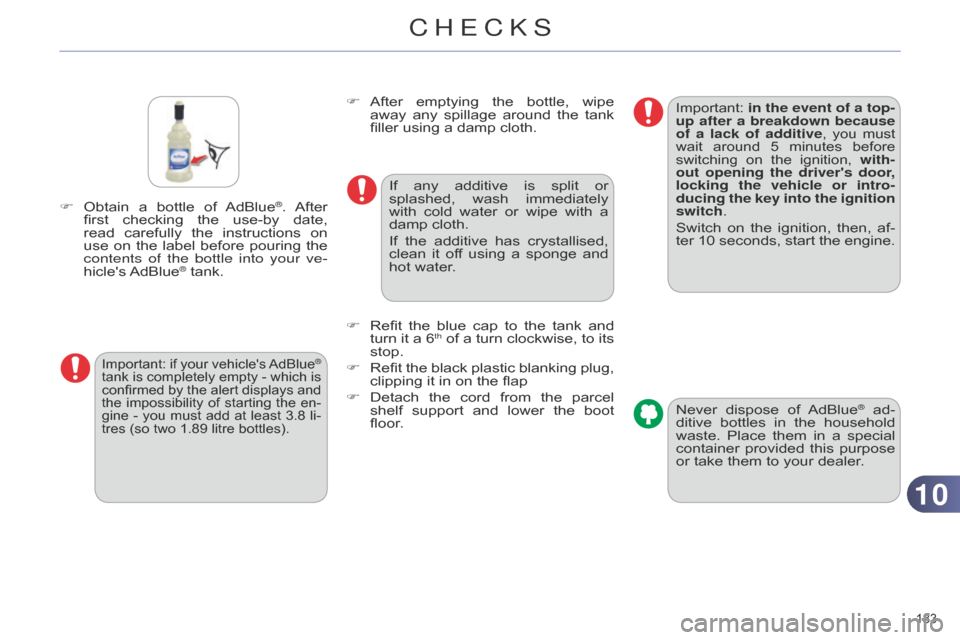
1010
183ô
Fô Obtainô a ô bottle ô of ô AdBlueôÛ.ô Afterô first
ô checking
ô the
ô use-by
ô date, ô
read
ô
carefully
ô
the
ô
instructions
ô
on
ô
use
ô
on
ô
the
ô
label
ô
before
ô
pouring
ô
the
ô
c
ontents of the bottle into your ve
-
hicle's
ô
AdBlueôÛô tank.
Important:ô if ô your ô vehicle's ô AdBlueôÛ
tank
ô is
ô completely
ô emptyô
-
ô which
ô is ô
confirmed
ô
by
ô
the
ô
alert
ô
displays
ô
and
ô
the
ô
impossibility
ô
of
ô
starting
ô
the
ô
en
-
gineô -
ô
you
ô
must
ô
add
ô
at
ô
least
ô
3.8ô
li-
tres
ô
(so
ô
two
ô
1.89
ô
litre
ô
bottles).
Fô After ô emptying ô the ô bottle, ô wipe ô away
ô any ô spilla ge ô around ô the ô tank ô
filler
ô using ô a ô damp ô cloth.
If
ô
any
ô
additive
ô
is
ô
split
ô
or
ô
splashed,
ô
wash
ô
immediately
ô
with
ô
cold
ô
water
ô
or
ô
wipe
ô
with
ô
a
ô
damp
ô cloth.
If
ô
the
ô
additive
ô
has
ô
crystallised,
ô
clean
ô
it
ô
of
f ô
using
ô
a
ô
sponge
ô
and
ô
hot
ô water.
F
ô
Refit
ô
the
ô
blue
ô
cap
ô
to
ô
the
ô
tank
ô
and
ô
turn
ô
it
ô
a
ô
6thô ofô a ô turn ô clockwise, ô to ô its ô stop.
F
ô
Refit
ô
the
ô
black
ô
plastic
ô
blanking
ô
plug,
ô
clipping
ô
it
ô
in ô on ô the ô flap
F
ô
Detach
ô
the
ô
cord
ô
from
ô
the
ô
parcel
ô
shelf
ô
support
ô
and
ô
lower
ô
the
ô
boot
ô
floor
. Never
ô
dispose
ô
of
ô
AdBlueôÛô ad-
ditive
ô bottles
ô in
ô the
ô household ô
waste.
ô
Place
ô
them
ô
in
ô
a
ô
special
ô
container
ô
provided
ô
this
ô
purpose
ô
or
ô
take
ô
them
ô
to
ô
your
ô
dealer.
Important:ô in the event of a top-
up after a breakdown because
of a lack of additive,
ô
you
ô
must
ô
wait
ô
around
ô
5
ô
minutes
ô
before
ô
switching
ô
on
ô
the
ô
ignition,
ô
with
-
out opening the driver's door,
locking the vehicle or intro-
ducing the key into the ignition
switch.
Switchô on ô the ô ignition, ô then, ô af -
ter ô 10 ô seconds, ô start ô the ô engine.
CHECKS
Page 186 of 328
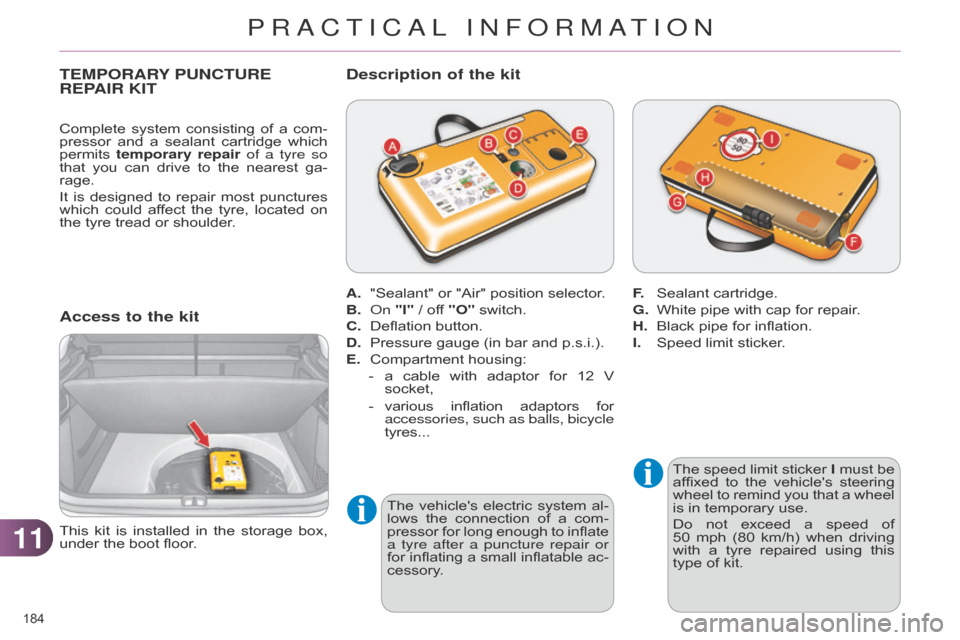
1111
184ô
TEMPORARY PUNCTURE REP
AIR KIT
Access to the kit
Theô speed ô limit ô sticker ô I ô must ô be ô affixed
ô to ô the ô vehicle's ô steering ô
wheel
ô
to
ô
remind
ô
you
ô
that
ô
a
ô
wheel
ô
is
ô in ô temporary ô use.
Do
ô
not
ô
exceed
ô
a
ô
speed
ô
of
ô
50ô
mph ô
(80
ô
km/h)
ô
when
ô
driving
ô
with
ô
a
ô
tyre
ô
repaired
ô
using
ô
this
ô
type
ô of ô kit.
This
ô
kit
ô
is
ô
installed
ô
in
ô
the
ô
storage
ô
box,
ô
under
ô
the
ô
boot
ô
floor. A.
ô
"Sealant"
ô
or
ô
"Air"
ô
position
ô
selector.
B.
o
n
"I"
ô
/
ô
off
ô
"O"
ô
switch.
C.
ô
Deflation
ô
button.
D.
ô
Pressure
ô
gauge
ô
(in
ô
bar
ô
and
ô
p.s.i.).
E.
ô
Compartment
ô
housing:
-
ô
a
ô
cable
ô
with
ô
adaptor
ô
for
ô
12
ô
V
ô
socket,
-
ô various
ô
inflation
ô
adaptors
ô
forô accessories,
such as balls, bicycle
tyres...
Description of the kit
F.ô Sealant ô cartridge.
G. ô
White
ô pipe ô with ô cap ô for ô repair.
H.
ô
Black
ô pipe ô for ô inflation.
I.
ô
Speed
ô limit ô sticker.
Complete
ô
system
ô
consisting
ô
of
ô
a
ô
com
-
pressor
ô
and
ô
a
ô
sealant
ô
cartridge
ô
which
ô
permits
ô
temporary repair
of a tyre so
that
ô
you
ô
can
ô
drive
ô
to
ô
the
ô
nearest
ô
ga
-
rage.
It
ô
is
ô
designed
ô
to
ô
repair
ô
most
ô
punctures
ô
which
ô
could
ô
af
fect
ô
the
ô
tyre,
ô
located
ô
on
ô
the
ô
tyre
ô
tread
ô
or
ô
shoulder.
The
ô
vehicle's
ô
electric
ô
system
ô
al
-
lows
ô
the
ô
connection
ô
of
ô
a
ô
com
-
pressor
ô
for
ô
long
ô
enough
ô
to
ô
inflate
ô
a tyre after a puncture repair or
for
ô
inflating
ô
a
ô
small
ô
inflatable
ô
ac
-
cessory.
PRACTICAL INFORMATION
Page 191 of 328

1111
189ô
CHANGING A WHEEL
Procedureô forô changing ô a ô faulty ô wheel ô for
ô the ô spare ô wheel ô using ô the ô tools ô pro -
vided
ô with ô the ô vehicle.
Access to the tools
Theô toolsô are ô installed ô in ô the ô boot ô under ô the
ô floor.
To
ô gain ô access ô to ô them:
F
open the boot,
F
ô
raise
ô the ô floor,
F
ô
secure
ô
it
ô
by
ô
hooking
ô
its
ô
cord
ô
on
ô
the
ô
hook
ô on ô the ô rear ô shelf ô support,
F
ô
with
ô
a
ô
standard
ô
size
ô
spare
ô
wheel,
ô
unclip
ô
and
ô
remove
ô
the
ô
box
ô
in
ô
the
ô
middle
ô
of
ô
the
ô
wheel
ô
containing
ô
the
ô
tools,
or
F
ô
with
ô
a
ô
"space-saver"
ô
spare
ô
wheel;
ô
lift
ô
the
ô
wheel
ô
at
ô
the
ô
rear
ô
towards
ô
you
ô
for
ô
access
ô
to
ô
the
ô
storage
ô
box
ô
con
-
taining
ô the ô tools. List of tools
All
ô
of
ô
these
ô
tools
ô
are
ô
specific
ô
to
ô
your
ô
vehicle.
ô
Do
ô
not
ô
use
ô
them
ô
for
ô
other
ô
pur
-
poses.
1. ô
Wheelbrace.
ô For
ô
removing
ô
the
ô
wheel
ô
trim
ô
and
ô
the
ô wheel ô fixing ô bolts.
2. ô
Jack
ô with ô integral ô handle.
ô For
ô raising ô the ô vehicle.
3. ô
"Bolt
ô cover" ô tool.
ô For
ô
removing
ô
the
ô
bolt
ô
protectors
ô
(covers)
ô on ô alloy ô wheels.
4. ô
Socket
ô
for
ô
the
ô
security
ô
bolts
ô
(lo
-
cated ô in ô the ô glove ô box).
ô For
ô
adapting
ô
the
ô
wheelbrace
ô
to
ô
the
ô
special
ô "security" ô bolts.
Wheel with trim
When removing the wheel,
detach ô
the
ô
trim
ô
first
ô
using
ô
the
ô
wheelbrace 1
ô
pullin
g ô
at
ô
the
ô
valve
ô
passage
ô hole.
When refitting the wheel,
ô
refit
ô
the
ô
trim
ô
starting
ô
by
ô
placing
ô
its
ô
notch
ô
facing
ô
the
ô
valve
ô
and
ô
press
ô
around
ô
its
ô
edge
ô
with
ô
the
ô
palm
ô
of
ô
your
ô hand.
PRACTICAL INFORMATION
Page 192 of 328
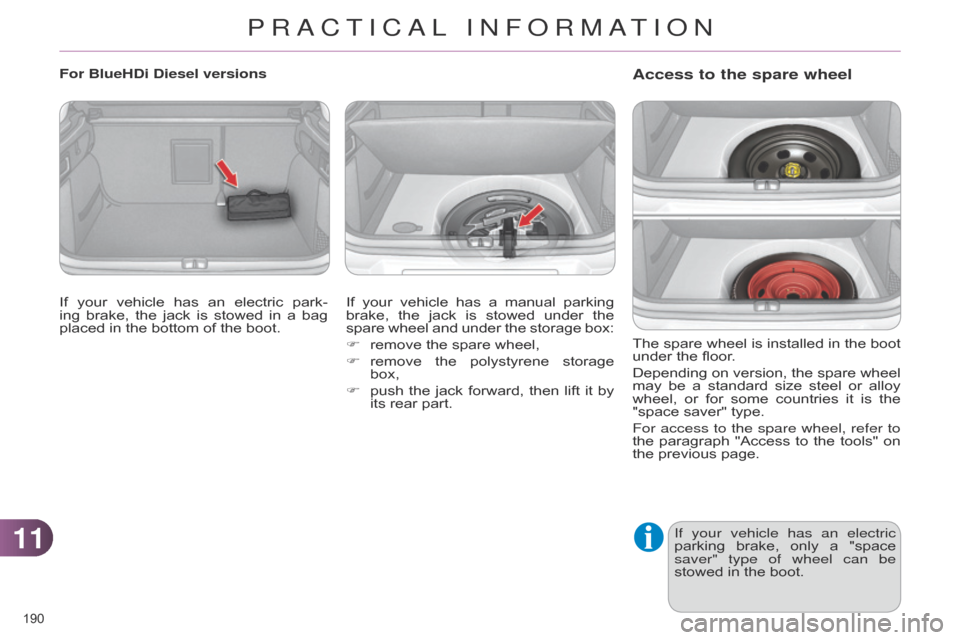
1111
190ô
Access to the spare wheel
Theô spareô wheel ô is ô installed ô in ô the ô boot ô under
ô the ô floor.
Depending
ô
on
ô
version,
ô
the
ô
spare
ô
wheel
ô
may
ô
be
ô
a
ô
standard
ô
size
ô
steel
ô
or
ô
alloy
ô
wheel,
ô
or
ô
for
ô
some
ô
countries
ô
it
ô
is
ô
the
ô
"space
ô saver" ô type.
For access to the spare wheel, refer to
the
ô
paragraph
ô
"Access
ô
to
ô
the
ô
tools"
ô
on
ô
the
ô previous ô page.
If your vehicle has an electric
parking
ô
brake,
ô
only
ô
a
ô
"space
ô
saver" type of wheel can be
stowed
ô in ô the ô boot.
For BlueHDi Diesel versions
If
ô
your
ô
vehicle
ô
has
ô
an
ô
electric
ô
park
-
ing
ô
brake,
ô
the
ô
jack
ô
is
ô
stowed
ô
in
ô
a
ô
bag
ô placed
ô
in
ô
the
ô
bottom
ô
of
ô
the
ô
boot. If
ô
your
ô
vehicle
ô
has
ô
a
ô
manual
ô
parking
ô
brake,
ô
the
ô
jack
ô
is
ô
stowed
ô
under
ô
the
ô spare
ô wheel
ô and
ô under
ô the
ô storage
ô box:
F
ô remove
ô
the
ô
spare
ô
wheel,
F
ô
remove
ô
the
ô
polystyrene
ô
storage
ô
box,
F
ô
push
ô
the
ô
jack
ô
forward,
ô
then
ô
lift
ô
it
ô
by
ô
its
ô
rear
ô
part.
PRACTICAL INFORMATION
Page 193 of 328

1111
191ô
Putting the standard wheel back in
placeTyre under-inflation detection
The
ô
spare
ô
wheel
ô
is
ô
not
ô
fitted
ô
with
ô
a
ô
sensor
. ô
The
ô
punctured
ô
wheel
ô
must
ô
be
ô
repaired
ô
by
ô
a
ô
CITROûN
ô
dealer
ô or ô aqualified ô workshop.
Taking out the standard wheel
Fô
Put
ô the ô wheel ô back ô in ô its ô housing.
F
ô
Unscrew
ô
the
ô
yellow
ô
central
ô
bolt
ô
by
ô
a
ô
few turns then put it in place in the
centre
ô of ô the ô wheel.
F
ô
T
ighten ô
fully
ô
until
ô
the
ô
central
ô
bolt
ô
clicks
ô to ô retain ô the ô wheel ô correctly.
F
ô
Unscrew
ô
the
ô
yellow
ô
central
ô
bolt.
F
ô
Raise
ô
the
ô
spare
ô
wheel
ô
towards
ô
you
ô
from
ô
the
ô
rear.
F
ô
T
ake
ô
the
ô
wheel
ô
out
ô
of
ô
the
ô
boot. F
ô
Put
ô
the
ô
box
ô
back
ô
in
ô
place
ô
in
ô
the
ô
cen
-
tre
ô of ô the ô wheel ô and ô clip ô it.
PRACTICAL INFORMATION
Page 196 of 328
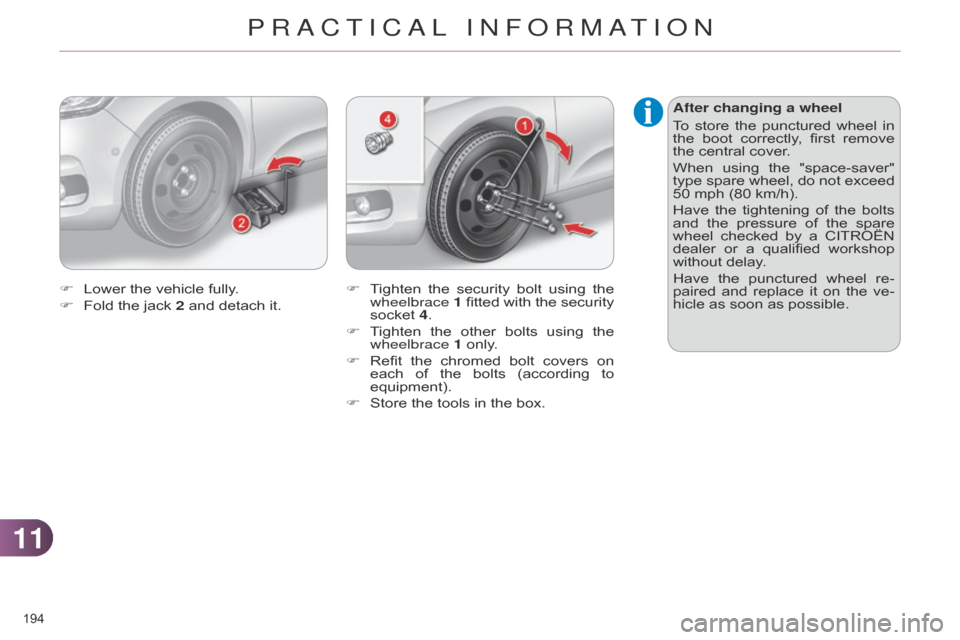
1111
194ô
After changing a wheel
Toô
store
ô
the
ô
punctured
ô
wheel
ô
in
ô
the
ô
boot
ô
correctly
, ô
first
ô
remove
ô
the
ô central ô cover.
When
ô
using
ô
the
ô
"space-saver"
ô
type
ô
spare
ô
wheel,
ô
do
ô
not
ô
exceed
ô
50
ô mph ô (80 ô km/h).
Have
ô
the
ô
tightening
ô
of
ô
the
ô
bolts
ô
and
ô
the
ô
pressure
ô
of
ô
the
ô
spare
ô
wheel
ô
checked
ô
by
ô
a
ô
CITROûN
ô
dealer
ô
or
ô
a
ô
qualified
ô
workshop
ô
without
ô delay.
Have
ô
the
ô
punctured
ô
wheel
ô
re
-
paired
ô
and
ô
replace
ô
it
ô
on
ô
the
ô
ve
-
hicle
ô as ô soon ô as ô possible.
F
ô
T
ighten
ô
the
ô
security
ô
bolt
ô
using
ô
the
ô
wheelbrace 1
ô
fitted
ô
with
ô
the
ô
security
ô
socket
ô
4.
F
ô
T
ighten
ô
the
ô
other
ô
bolts
ô
using
ô
the
ô
wheelbrace
1
ô
only.
F
ô
Refit
ô
the
ô
chromed
ô
bolt
ô
covers
ô
on
ô
each
ô
of
ô
the
ô
bolts
ô
(according
ô
to
ô
equipment).
F
ô
Store
ô
the
ô
tools
ô
in
ô
the
ô
box.
F
ô
Lower
ô
the
ô
vehicle
ô
fully.
F
ô
Fold
ô
the
ô
jack
ô
2
ô
and
ô
detach
ô
it.
PRACTICAL INFORMATION
Page 202 of 328
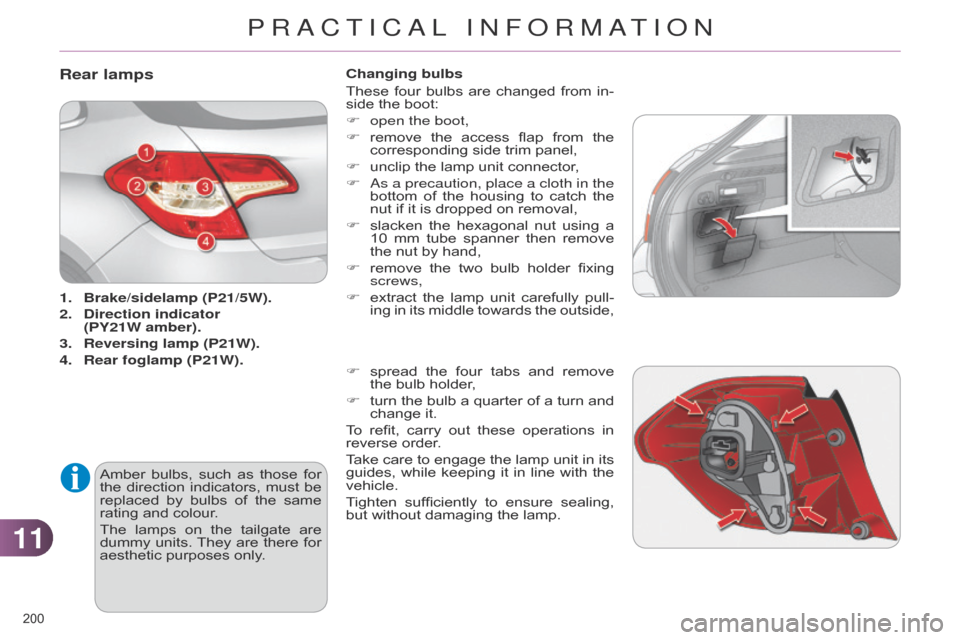
1111
200ô
Rear lamps
1. Brake/sidelamp (P21/5W).
2.
Direction
indicator
(PY21W amber).
3.
Reversing lamp (P21W).
4.
Rear
foglamp (P21W).
Amber
ô
bulbs,
ô
such
ô
as
ô
those
ô
for
ô
the
ô
direction
ô
indicators,
ô
must
ô
be
ô
replaced
ô
by
ô
bulbs
ô
of
ô
the
ô
same
ô
rating
ô and ô colour.
The
ô
lamps
ô
on
ô
the
ô
tailgate
ô
are
ô
dummy
ô
units.
ô
They
ô
are
ô
there
ô
for
ô
aesthetic
ô purposes ô only.Changing bulbs
These
ô
four
ô
bulbs
ô
are
ô
changed
ô
from
ô
in
-
side ô the ô boot:
F
open the boot,
F
ô
remove
ô
the
ô
access
ô
flap
ô
from
ô
the
ô
corresponding
ô side ô trim ô panel,
F ô
unclip
ô the ô lamp ô unit ô connector,
F a s a precaution, place a cloth in the
bottom ô
of
ô
the
ô
housing
ô
to
ô
catch
ô
the
ô
nut
ô if ô it ô is ô dropped ô on ô removal,
F ô
slacken
ô
the
ô
hexagonal
ô
nut
ô
using
ô
a
ô
10
ô
mm
ô
tube
ô
spanner
ô
then
ô
remove
ô
the
ô nut ô by ô hand,
F ô
remove
ô
the
ô
two
ô
bulb
ô
holder
ô
fixing
ô
screws,
F
ô extract ô the ô lamp ô unit ô carefully ô pull -
ing ô in ô its ô middle ô towards ô the ô outside,
F
ô
spread
ô
the
ô
four
ô
tabs
ô
and
ô
remove
ô
the
ô bulb ô holder,
F
ô
turn
ô
the
ô
bulb
ô
a
ô
quarter
ô
of
ô
a
ô
turn
ô
and
ô
change
ô it.
To
ô
refit,
ô
carry
ô
out
ô
these
ô
operations
ô
in
ô
reverse
ô order.
Take
ô
care
ô
to
ô
engage
ô
the
ô
lamp
ô
unit
ô
in
ô
its
ô
guides,
ô
while
ô
keeping
ô
it
ô
in
ô
line
ô
with
ô
the
ô
vehicle.
T
ighten ô
sufficiently
ô
to
ô
ensure
ô
sealing,
ô
but
ô without ô damaging ô the ô lamp.
PRACTICAL INFORMATION
Page 205 of 328
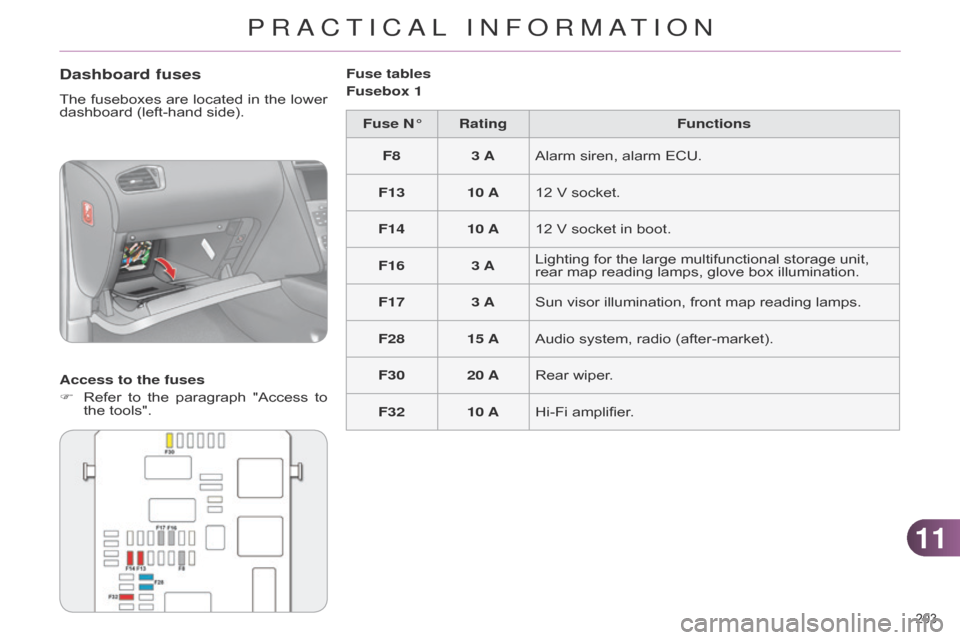
1111
203ô
Dashboard fuses
Theô fuseboxesô are ô located ô in ô the ô lower ô dashboard
ô (left-hand ô side).
Access to the fuses
F
ô
Refer
ô
to
ô
the
ô
paragraph
ô
"Access
ô
to
ô
the
ô tools". Fuse tables
Fusebox 1
Fuse Nô¯ Rating Functions
F8 3 AAlarm
ô siren, ô alarm ô ECU.
F13 10 A12
ô V ô socket.
F14 10 A12
ô V ô socket ô in ô boot.
F16 3 ALighting
ô for ô the ô large ô multifunctional ô storage ô unit, ô
rear
ô map ô reading ô lamps, ô glove ô box ô illumination.
F17 3 ASun
ô visor ô illumination, ô front ô map ô reading ô lamps.
F28 15 AAudio
ô system, ô radio ô (after-market).
F30 20 ARear
ô wiper.
F32 10 AHi-Fi
ô amplifier.
PRACTICAL INFORMATION
Page 213 of 328
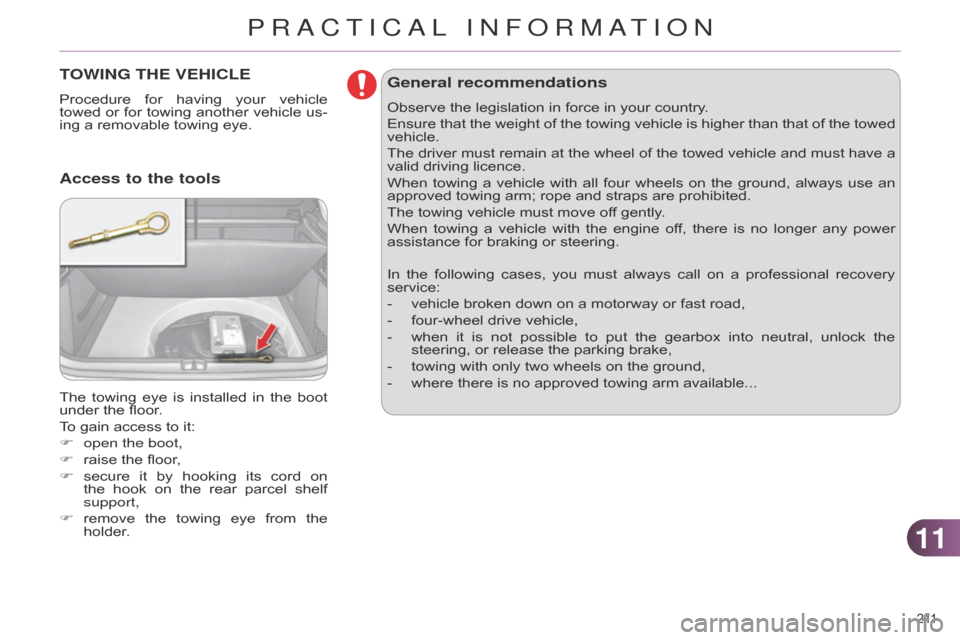
1111
211ô
TOWING THE VEHICLE
Procedureô for ô having ô your ô vehicle ô towed
ô or ô for ô towing ô another ô vehicle ô us -
ing
ô a ô removable ô towing ô eye.
The
ô
towing
ô
eye
ô
is
ô
installed
ô
in
ô
the
ô
boot
ô
under
ô the ô floor.
To
ô gain ô access ô to ô it:
F
open the boot,
F
ô
raise
ô the ô floor,
F
ô
secure
ô
it
ô
by
ô
hooking
ô
its
ô
cord
ô
on
ô
the
ô
hook
ô
on
ô
the
ô
rear
ô
parcel
ô
shelf
ô
support,
F
ô
remove
ô
the
ô
towing
ô
eye
ô
from
ô
the
ô
holder
.
Access to the tools General recommendations
Observeô theô legislationô inô forceô inô yourô country.
Ensure ô
that
ô
the
ô
weight
ô
of
ô
the
ô
towing
ô
vehicle
ô
is
ô
higher
ô
than
ô
that
ô
of
ô
the
ô
towed
ô
vehicle.
The
ô
driver
ô
must
ô
remain
ô
at
ô
the
ô
wheel
ô
of
ô
the
ô
towed
ô
vehicle
ô
and
ô
must
ô
have
ô
a
ô
valid
ô driving ô licence.
When
ô
towing
ô
a
ô
vehicle
ô
with
ô
all
ô
four
ô
wheels
ô
on
ô
the
ô
ground,
ô
always
ô
use
ô
an
ô
approved
ô towing ô arm; ô rope ô and ô straps ô are ô prohibited.
The
ô towing ô vehicle ô must ô move ô off ô gently.
When
ô
towing
ô
a
ô
vehicle
ô
with
ô
the
ô
engine
ô
of
f, ô
there
ô
is
ô
no
ô
longer
ô
any
ô
power
ô
assistance
ô for ô braking ô or ô steering.
In
ô
the
ô
following
ô
cases,
ô
you
ô
must
ô
always
ô
call
ô
on
ô
a
ô
professional
ô
recovery
ô
service:
-
ô
vehicle
ô broken ô down ô on ô a ô motorway ô or ô fast ô road,
-
ô
four-wheel
ô drive ô vehicle,
-
ô
when
ô
it
ô
is
ô
not
ô
possible
ô
to
ô
put
ô
the
ô
gearbox
ô
into
ô
neutral,
ô
unlock
ô
the
ô
ô
steering,
ô or ô release ô the ô parking ô brake,
-
ô
towing
ô with ô only ô two ô wheels ô on ô the ô ground,
-
ô
where
ô there ô is ô no ô approved ô towing ô arm ô available...
PRACTICAL INFORMATION